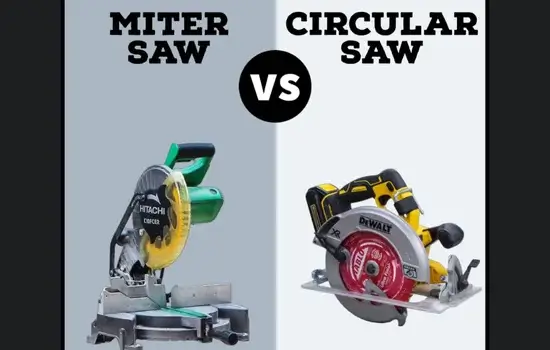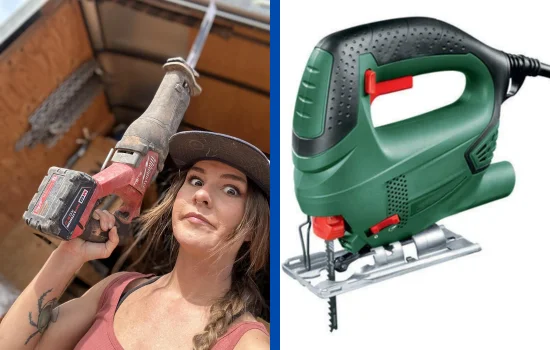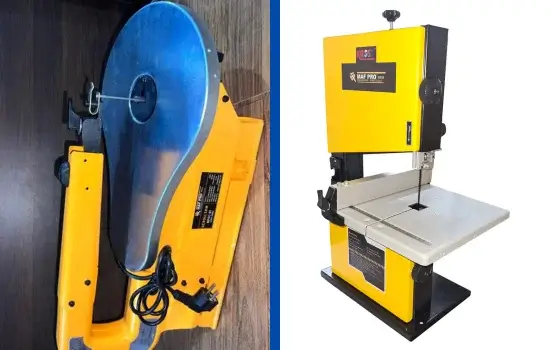When it comes to power tools, two of the most commonly used saws in woodworking, DIY projects, and home renovations are the miter saw and the circular saw. While both saws are versatile and effective, they have different strengths and are best suited to specific tasks. Understanding these differences can help you choose the right tool for your needs, whether you’re building furniture, installing trim, or making general cuts.
In this article, we’ll dive deep into the capabilities, unique features, and ideal applications of both miter saws and circular saws, and provide a comprehensive comparison to guide your selection.
Quick Definitions of Miter Saw and Circular Saw
Miter Saw
A miter saw is a specialized tool primarily designed to make accurate angle cuts on smaller pieces of material. Mounted on a pivoting arm, it allows for precise cuts at a range of angles. Many miter saws also offer bevel capabilities, which enable users to make angled cuts along two axes simultaneously. Miter saws are ideal for crosscuts, miter cuts, and bevel cuts in woodworking, particularly in trim work and framing.
Circular Saw
A circular saw is a handheld power tool that uses a rotating disc blade to cut through various materials. Unlike a miter saw, a circular saw is highly portable and is not limited to crosscuts. It can make rip cuts (cutting along the length of a board), crosscuts, bevel cuts, and more. Circular saws are excellent for general-purpose cutting and are commonly used on large workpieces, such as plywood sheets.
Key Differences Between Miter Saw and Circular Saw
| Feature | Miter Saw | Circular Saw |
|---|---|---|
| Primary Function | Accurate crosscuts, angle cuts, and bevel cuts | General-purpose cutting on various materials |
| Cutting Motion | Pivoting motion on a fixed base | Freehand, moving across the material |
| Portability | Stationary, limited portability | Highly portable, handheld |
| Angle Adjustment | Easily adjustable angles and bevels | Can make bevel cuts, but no built-in miter option |
| Cutting Accuracy | High, ideal for precise cuts | Moderate, depends on user skill |
| Cutting Capacity | Limited to board width and miter saw size | Suitable for both large panels and boards |
| Applications | Trim work, framing, molding | General carpentry, large panels, framing |
| Safety Features | Blade guard, lock-off switch, safety clamps | Blade guard, electric brake on some models |
| Cost | Mid-range to high | Budget-friendly to mid-range |
Detailed Comparison of Miter Saw and Circular Saw
1. Primary Purpose and Cutting Capabilities
- Miter Saw: The miter saw is designed for making accurate, repetitive cuts at various angles, making it perfect for projects like trim work, framing, and cutting molding. Miter saws excel at crosscuts and can cut materials at specific angles with precision. Certain models, like compound miter saws, offer dual-bevel capabilities, allowing users to make compound cuts (both miter and bevel cuts simultaneously), which is particularly useful in complex woodworking projects.
- Circular Saw: The circular saw is highly versatile and can perform a range of cuts, including rip cuts, crosscuts, and even bevel cuts when adjusted. Since it’s handheld, a circular saw is not limited by the dimensions of a fixed base and can be used on large panels and longer boards. Circular saws are ideal for general carpentry work, especially for cutting plywood sheets, making framing cuts, and ripping boards to width.
2. Cutting Motion and Material Handling
- Miter Saw: Miter saws are fixed tools that require the material to be placed against a fence and cut using a pivoting blade. The saw is limited in cutting width by the diameter of the blade and the size of the saw. While sliding miter saws increase cutting capacity by allowing the blade to slide forward, they are still limited in their ability to handle large sheets and are best suited for smaller pieces of wood or trim.
- Circular Saw: With a circular saw, the user moves the saw across the material rather than moving the material itself. This allows for greater flexibility in handling large pieces, such as plywood sheets. Circular saws are also suitable for cutting longer boards, and with the help of a straight-edge guide, they can make straight cuts similar to a table saw’s rip cut.
3. Portability and Workspace Requirements
- Miter Saw: Miter saws are stationary tools that need a stable surface to operate, usually requiring a dedicated space in a workshop or garage. Some miter saws come with portable stands or can be placed on workbenches, but their setup is not as convenient for on-the-go jobs. They are less portable than circular saws, making them best suited for projects that are confined to a specific work area.
- Circular Saw: Circular saws are highly portable, compact, and can be used in various locations, whether in a workshop, at a job site, or even outdoors. They don’t require a dedicated work surface, making them extremely versatile for different cutting tasks in diverse settings. Their portability is a major advantage for carpenters and contractors who work on multiple job sites.
4. Angle Adjustability and Precision
- Miter Saw: Miter saws are known for their precision in angle adjustment. They come with adjustable angle settings that allow for precise miter cuts, typically up to 45 degrees or more in either direction. Most miter saws also include beveling capabilities, allowing users to make bevel cuts by tilting the blade. Dual-bevel miter saws are even more versatile, enabling compound cuts without needing to adjust the workpiece.
- Circular Saw: Circular saws can also make bevel cuts by adjusting the angle of the blade, but they do not have a built-in miter function for angle adjustments. Any angled cuts must be done freehand or with an additional guide or jig. The accuracy of angle cuts on a circular saw largely depends on the user’s skill and the use of guides, making it less precise than a miter saw for these types of cuts.
5. Cutting Capacity and Versatility
- Miter Saw: The cutting capacity of a miter saw is limited by its blade size and the depth and width of its cutting area. For instance, a 10-inch miter saw can generally cut through materials up to 6 inches wide, while a 12-inch model can handle up to 8 inches. Sliding miter saws extend this cutting range, but they are still limited in versatility compared to a circular saw when it comes to handling large panels or making rip cuts.
- Circular Saw: Circular saws are not confined to the cutting dimensions of a fixed base, allowing them to cut large sheets of material and make both rip cuts and crosscuts. With a high-quality circular saw blade, these saws can handle thicker wood and dense materials. Their versatility in cutting capacity makes circular saws ideal for a wide range of tasks, from construction work to DIY projects.
6. Safety Features
- Miter Saw: Miter saws have several safety features, including a blade guard that covers the blade when not in use. Many miter saws also have a lock-off switch that prevents accidental activation, as well as clamps to secure the material to the workbench. These safety features make miter saws relatively safe to use, as the material remains stationary while the blade moves.
- Circular Saw: Circular saws are equipped with a blade guard that retracts as the saw engages the material and an electric brake on some models that stops the blade quickly once the trigger is released. However, circular saws require more caution, as they are handheld tools, and the blade remains exposed during use. Users should always wear safety goggles, maintain a secure grip, and use proper techniques to minimize the risk of accidents.
7. Cost Considerations
- Miter Saw: Miter saws range from mid-range to high in price, depending on features like blade size, sliding capabilities, and dual bevel options. Compound and sliding compound miter saws are more expensive but offer additional versatility for advanced woodworking. Overall, miter saws can be an investment, especially for users who need high precision.
- Circular Saw: Circular saws are generally more affordable than miter saws and are available in a wide range of price points. Basic models are budget-friendly, while high-end models with advanced features like electric brakes and higher power can cost more. Given their versatility and lower price, circular saws are often the first choice for DIYers and hobbyists on a budget.
Pros and Cons of Miter Saw and Circular Saw
Miter Saw Pros:
- Highly accurate for angle and bevel cuts
- Easy to set up and repeat cuts with precision
- Excellent for trim work, framing, and molding
- Safer for beginners due to stationary setup and built-in safety features
Miter Saw Cons:
- Limited portability, requires a dedicated workspace
- Restricted cutting capacity, not ideal for large sheets or rip cuts
- More expensive than circular saws, especially for sliding or compound models
Circular Saw Pros:
- Highly versatile for a variety of cuts (rip, crosscut, bevel)
- Portable and easy to use on-site or in different locations
- Affordable, with budget options available for beginners
- Ideal for larger pieces and sheets, as well as general-purpose cutting
Circular Saw Cons:
- Requires skill for accurate angle cuts, no built-in miter function
- More safety risks due to handheld operation and exposed blade
- Limited precision compared to a miter saw for angled or repetitive cuts
Choosing Between a Miter Saw and a Circular Saw
Your choice between a miter saw and a circular saw will depend on the types of projects you plan to undertake:
- If your projects involve precise angle cuts, repetitive crosscuts, or trim work, a miter saw is the ideal choice. It’s particularly useful for tasks that require clean, accurate cuts in wood, such as picture frames, molding, and other detail work. While it requires a stable workspace, the miter saw’s precision is unmatched for angle and bevel cuts.
- If you’re looking for a versatile, portable tool for general-purpose cutting on large boards or sheets, a circular saw is the better option. It’s more adaptable to different tasks, and its portability makes it ideal for contractors or anyone who works in various locations. With a guide, you can achieve straight cuts, and the saw’s flexibility makes it useful for a variety of materials and projects.
For many woodworking enthusiasts, having both a miter saw and a circular saw provides the best of both worlds, offering accuracy for detailed cuts and flexibility for larger, rougher cuts.
Conclusion
Miter saws and circular saws are both essential tools in woodworking, but they each have unique advantages suited to specific applications. By understanding their strengths and limitations, you can make an informed choice that matches your project needs, ensuring you have the right tool to achieve quality results. Whether you need precision or versatility, selecting the right saw will improve your efficiency, safety, and satisfaction in your work.


